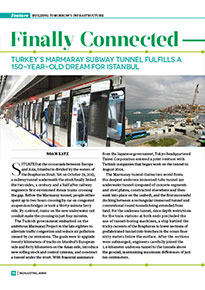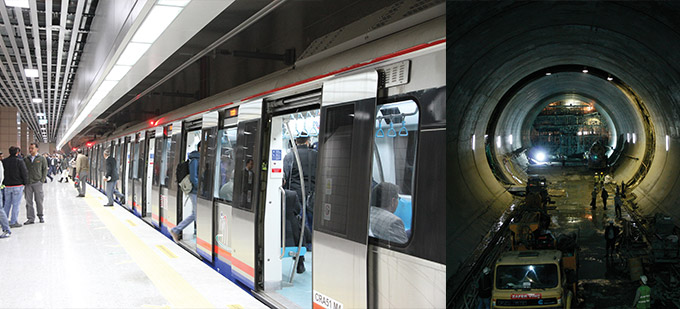Home > Highlighting JAPAN >Highlighting Japan December 2014>Building Tomorrow's Infrastructure
Highlighting JAPAN

Building Tomorrow's Infrastructure
Finally Connected
Turkey’s Marmaray Subway Tunnel Fulfills
a 150-Year-old Dream for Istanbul

Situated at the crossroads between Europe and Asia, Istanbul is divided by the waters of the Bosphorus Strait. Yet on October 29, 2013, a railway tunnel underneath the strait finally linked the two sides, a century and a half after railway engineers first envisioned steam trains crossing the gap. Before the Marmaray tunnel, people either spent up to two hours crossing by car on congested suspension bridges or took a thirty-minute ferry ride. By contrast, trains on the new underwater rail conduit make the crossing in just four minutes.
The Turkish government embarked on the ambitious Marmaray Project in the late eighties to alleviate traffic congestion and reduce air pollution caused by car emissions. The goals were to upgrade twenty kilometers of tracks on Istanbul’s European side and forty kilometers on the Asian side, introduce new rolling stock and control systems, and construct a tunnel under the strait. With financial assistance from the Japanese government, Tokyo-headquartered Taisei Corporation entered a joint venture with Turkish companies that began work on the tunnel in August 2004.
The Marmaray tunnel claims two world firsts: the deepest undersea immersed tube tunnel (an underwater tunnel composed of concrete segments and steel plates, constructed elsewhere and then sunk into place on the seabed), and the first successful docking between a rectangular immersed tunnel and conventional round tunnels being extended from land. For the undersea tunnel, since depth restrictions for the train stations at both ends precluded the use of tunnel-boring machines, a ship battled the tricky currents of the Bosphorus to lower sections of prefabricated tunnel into trenches in the ocean floor sixty meters below the surface. After the sections were submerged, engineers carefully joined the 1.4-kilometer undersea tunnel to the tunnels above the ground, maintaining maximum differences of just ten centimeters.
Takashi Imaishi, the acting general manager in the Civil Engineering Department of Taisei Corporation’s international operations headquarters, was directly involved in the project. The demanding technical requirements notwithstanding, what Imaishi remembers the most are the challenges that cultural norms presented.
“This was the first time we’d done business in Turkey, and the regulations and business sense were completely different from Japan,” he says, explaining how the local approach to work in accordance with Turkish religious customs meant that “we couldn’t proceed on a Japanese schedule.”
The project’s location posed significant headaches as well. Istanbul’s lengthy history has led to excavations that unearthed historical sites from the Ottoman, Byzantine, Roman and Grecian periods, along with even older artifacts dating back up to 8,500 years. Archeological surveys performed each time ruins were discovered brought construction to a standstill, and ultimately delayed the project’s completion by nearly five years. Nevertheless, “we learned new things about Istanbul’s history,” says Imaishi, citing the remains of a cargo ship from the Roman period found intact, which provided historians with valuable clues to historical trade routes. Some of these artifacts are now showcased in Yenikapı Station’s open museum.
According to Imaishi, Japanese construction companies like Taisei are well-suited for these kinds of projects because they possess in-house research laboratories and designers, in contrast to foreign construction companies that typically contract out for research and design. He says this allowed for a more flexible response to unexpected requests during the Marmaray Project. Expertise in earthquake-resistant construction was also an asset, since the undersea tunnel had to be built to last a hundred years.
Imaishi says ridership on the new subway is high and passengers appreciate the savings in both time and cost, although operation is still limited. The tunnel already represents not only better access in Istanbul, but also a testament to the power of Japanese technology.
© 2009 Cabinet Office, Government of Japan






